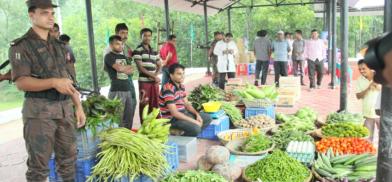Markets along India-Bangladesh borders to empower women, enrich villages
The Border Haats (markets) along the India-Bangladesh boundaries would prosper the frontier villages and adjoining areas, besides economically empowering the people, especially the women, living on both sides of the borders, experts, economists and researchers said

The Border Haats (markets) along the India-Bangladesh boundaries would prosper the frontier villages and adjoining areas, besides economically empowering the people, especially the women, living on both sides of the borders, experts, economists and researchers said. Four Border Haats were set up along the India-Bangladesh borders in Meghalaya and Tripura in 2011, 2012 and 2015, while six more -- four in Meghalaya and two in Tripura -- have been approved by the governments of the two countries to promote local business and livelihoods of people living along the frontiers.
These Border Haats, however, have remained closed since March last year as a precautionary measure against the outbreak of the Covid-19 pandemic and the consequent lockdowns, causing immense loss to the people living in the bordering villages.
The Additional District Magistrate of Sepahijala in western Tripura, Subhasis Bandopadhay, who is also the co-chairman of one of Tripura's two Border Haats management committee, had told IANS that as the Covid induced situation has been largely tamed in India and Bangladesh, both the countries are keen to reopen the bordering markets.
CUTS International, a Jaipur-based think-tank and NGO, which has conducted several studies on border trade and Border Haats, had also recommended to the Indian government to resume these border markets by maintaining the necessary precautions against Covid-19, including social distancing, as these markets boost the economy, fortify ties among the people of the two neighbours and also check illegal trades.
The Executive Director of CUTS International, Bipul Chatterjee, said in a virtual dialogue on Thursday: "To up-scale the India-Bangladesh Border Haats initiative, we need to work much more closely with the security agencies across the borders, in state capitals and national capitals."
Chatterjee underlined the need for further engagement with the border communities to identify specific issues and accordingly make policy recommendations at the local, state and national levels.
Professor and Director at the Bangladesh-based Institute of Disaster Management and Vulnerability Studies, Mahbuba Nasrin, said that Border Haats have facilitated the participation of women from the border areas in economic activities. "They instilled confidence in them that they are capable of running business," Nasrin said.
She also mentioned that cultural identity of women and social construct of the locality along with women-friendly infrastructure can play a significant role in driving them to enhance their participation in the Border Haats.
"In order to enhance women's participation, focus should be on creating a better environment by looking at a number of parameters such as financial support, flexible hours, provision for skill and capacity enhancement, awareness generation for gender-sensitive community building, etc.," Nasrin said.
The virtual discussion was jointly organised by CUTS International and Bangladesh's leading NGO 'Unnayan Shamannay', to discuss the 'need for up-scaling India-Bangladesh Border Haats - what, why and how'. The panellists talked about looking at the Border Haats as a nucleus for attaining cross-border peace, security, stability and prosperity.
The virtual discussion was based on three recently published study papers as part of a project on India-Bangladesh Border Haats supported by the Foreign, Commonwealth and Development Office of the UK, under its Asia Regional Trade and Connectivity Programme.
Speaking on the occasion, Sabyasachi Dutta, Executive Director, Asian Confluence, a Shillong-based think-tank and research group, emphasised on enabling local people to witness real benefits of developmental initiatives. He said that Border Haats should be perceived as a part of 'border co-prosperity zone' promoting inclusive growth.
"This generational shift can be achieved by trade, transit and tourism aiming at building better trust among the communities across the border," he added.
Dutta also suggested organising curated programmes, conferences, cultural events at the Border Haats so as to create better stories for the media. "The spotlight should be on development at the border and not through the border," he said.
Veteran Bangladeshi scribe Asjadul Kibria emphasised on the role of media in presenting case studies on Border Haats for generating knowledge and understanding their effectiveness among the common people.
Nisha Taneja, professor of New Delhi-based Indian Council for Research on International Economic Relations, talked about the advantages that the Border Haats bring to the table, such as enabling the cross-border exchange of goods with least procedural compliances.
"The Border Haats have been a significant driver of employment in the border region, boosting cross-border economic activities. However, it remains to be seen if reservations for women traders can become a reality," she added.
According to Monoj Kumar Roy, former Additional Secretary in the Commerce Ministry of Bangladesh, in order to escalate the benefits of the Border Haats, a demand assessment study should be conducted across the border and accordingly border communities should be capacitated so that they can easily sell the products.
Tania Haque, professor at the Department of Women and Gender Studies, Dhaka University, and senior journalist from the northeast, Ratul Baruah, also participated in the discussion, and suggested to widen the business scope of the Border Haats, where diverse local produces are traded.
(IANS)








Post a Comment